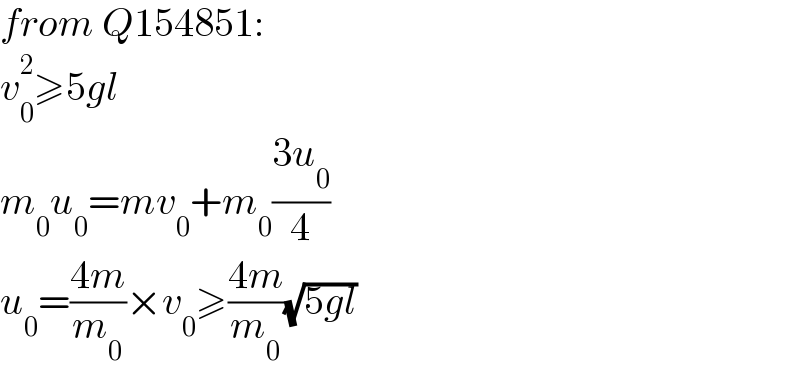
Question and Answers Forum
Question Number 155034 by peter frank last updated on 24/Sep/21

Commented by peter frank last updated on 24/Sep/21

Commented by mr W last updated on 24/Sep/21

Commented by mr W last updated on 24/Sep/21

Commented by mr W last updated on 24/Sep/21

Answered by mr W last updated on 24/Sep/21

Answered by peter frank last updated on 25/Sep/21

Commented by peter frank last updated on 25/Sep/21

Answered by peter frank last updated on 25/Sep/21

Commented by peter frank last updated on 25/Sep/21

Commented by peter frank last updated on 25/Sep/21
![since there are collision, momentum is conserved Momentum before collisio(M_(bc) )= Momentum after collision(M_(apc) )= u_o m_o +m_B u_B =(3/4)m_o u_o +Mv_B u_B =0 v_B =((m_o u_o )/(4M)) ...(i) Total Energy at the bottom= Total Energy at the Top(highest) E_B =E_T K.E_B +P.E_B =K.E_H +P.E_H (1/2)Mv_o ^2 +mg(0)=(1/2)Mv_H ^2 +mg(l+l) v_B ^2 =v_H ^2 +4gl ....(ii) (((m_o u_o )/(4M)) )^2 =V_H ^2 +4gl v_H ^2 =((m_o ^2 u_o ^2 )/(16M)) −4gl .....(iii) for any particle to complete a circle safely ((mv_H ^2 )/r)>mg (v_H ^2 /r)>g v_H ^2 >gr .....(iv) ((m_o ^2 u_o ^2 )/(16M)) −4gl >gr [r=l] ((m_o ^2 u_o ^2 )/(16M)) >5gl m_o ^2 u_o ^2 >80Mgl u_o >((√(80Mgl))/m_o ) u_o >((4M(√(5gl)))/m_o ) u_o =((4M(√(5gl)))/m_o )](Q155095.png)
